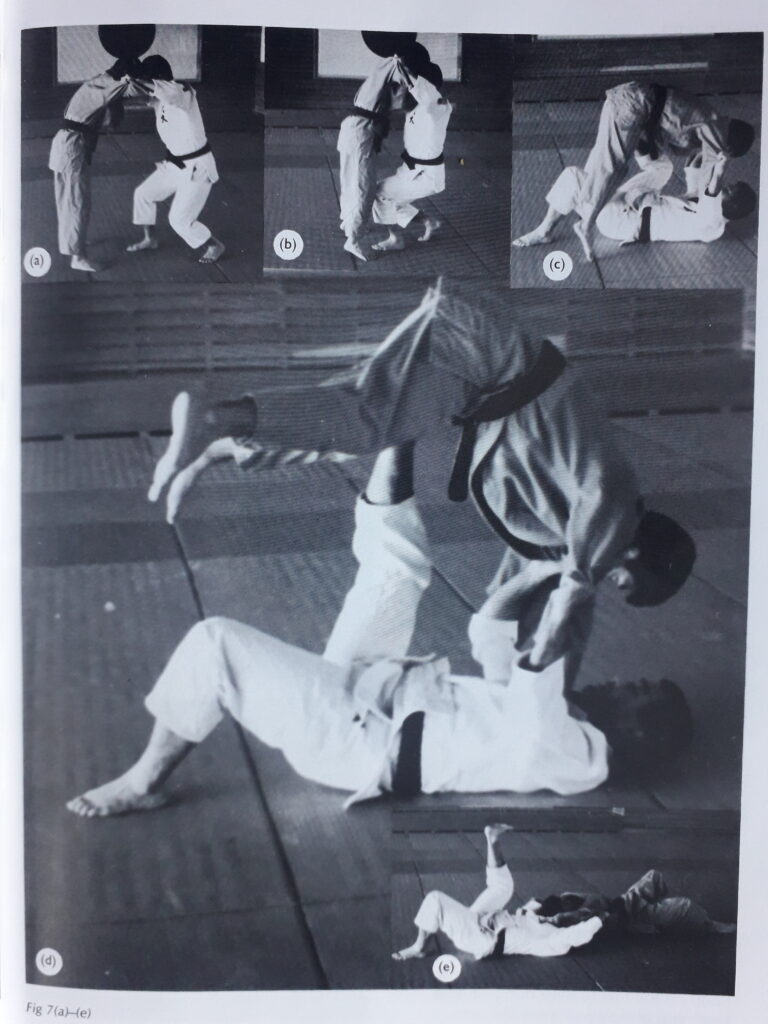Unit 46 – Tomoe Nage Instructional
Difficulty: Medium
Time: 4 minute 30 seconds
(This module is very similar to one that appeared on the March 2012 GAMSAT, which was themed on fishing and required students to interpret both text and illustrations together)
Adapted from ‘Judo Masterclass Techniques: Tomoe Nage’ by Katsuhiko Kashiwazaki

The success of this throw depends on two crucial elements; an effective break of balance and an extremely deep entry.
(a) Here we see demonstrated the standard sleeve/lapel grip. The kuzushi (breaking of balance) for tomoe-nage is markedly different to most other judo throws. As can be seen from the photograph, I pull slightly up with both hands, but also outwards, to ‘open’ my opponent. It is a movement that is maintained throughout the throw: even when I am on my back, my arms are pulling wide. At the same time, I am starting my first step. Of course, in competition the number of steps will most likely need to be reduced, but it is best to begin a tomoe-nage study using a two-step entry.
(b) My pull continues as I take my second step, deep in between my opponent’s feet. The eventual success of the throw will depend largely on how deep my entry is.
(c) As I drop, I place my throwing foot safely in my opponent’s groin/hip area, just below the belt. In ju-jitsu days the foot would have been placed lower for maximum damage and effectiveness, but in judo this is not necessary.
(d) I keep my throwing leg bent until I have drawn my opponent well on to the throw. Many tomoe-nage attacks fail because the throwing leg is straightened too early. It is only when the opponent is well in the air that it is necessary to straighten the leg. Any earlier, and he is simply pushed away.
(e) To add extra impetus I pull in tight with my hands shortly before my opponent hits the mat.
1. In comparison to the sport of judo, ju-jitsu is portrayed as:
- A Ineffective
- B Comical
- C Brutal
- D Old-fashioned
2. To complete the throw, the attacker’s leg functions most similarly to a:
- A Pivot
- B Fulcrum
- C Bow
- D Spring
3. The combat scenario shown above is portrayed as:
- A Typical
- B Ideal
- C Exaggerated
- D Simplified
Highlight the text below to reveal the answers:
Q1: C
The answer lies in part (c), “In ju-jitsu days the foot would have been placed lower for maximum damage and effectiveness.” Lower than the target ‘groin/hip’ area is where the genitals reside, so the author is implying that the move would have been performed concurrently with kicking the opponent there in order to cause more harm. This method is no less ‘effective’ and there is no indication as to how long ago these ‘ju-jitsu days’ were. Whether or not it is more comical is subjective but the author himself makes no joke of it.
Q2: D
If the leg stayed rigid and straight throughout the movement it would act most like a fulcrum or pivot – a point around or over which the opponent would be leveraged. Photos (d) and (e) show that the leg straightens, essentially kicking the opponent off to the rear. This movement is similar to the effect of a compressed spring releasing its tension. A bow is a tightly-sprung arc, and is not really applicable to anything in the movement shown.
Q3: B
The first hint for this question is provided in the text:
“Of course, in competition the number of steps will most likely need to be reduced, but it is best to begin a tomoe-nage study using a two-step entry.” This suggests that the movement would be performed differently in a competition where, we can assume, the opponent would be resisting. The technique shown in the photos is therefore not a real-life combat scenario or even close to it.
The second hint (the result of which could probably be inferred anyway) is: “It is only when the opponent is well in the air that it is necessary to straighten the leg. Any earlier, and he is simply pushed away.” – this common mistake, not shown, suggests that the throw that is pictured is technically correct – as would be expected from an instructional.
Put this all together and we get a finely choreographed movement on an unresisting opponent. The technique is explained in detail (it has not been obviously simplified). Furthermore, we can infer from the following sentence that the writer omitted unnecessary accessories to the technique.
“In ju-jitsu days the foot would have been placed lower for maximum damage and effectiveness, but in judo this is not necessary.”
This leaves only B, ideal. In a perfect scenario, this is how the throw would look.
